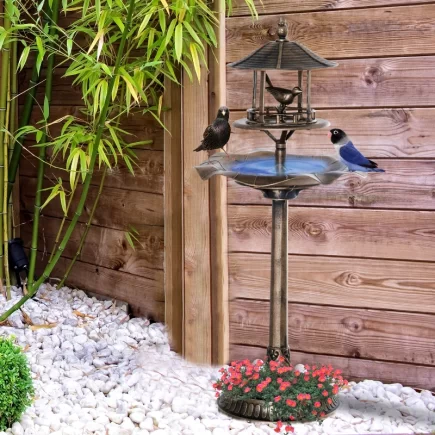A ceiling fan does more than cool a room, it adds to your home’s overall look. But over time, dust, fading, or outdated colors can make even a good fan appear worn out. Instead of replacing it, a fresh coat of paint can completely renew its style and match your décor.

Painting a ceiling fan is a simple, cost-effective weekend project that can completely refresh its look. In this complete guide, you’ll learn exactly how to remove, clean, paint, and reinstall your fan safely for professional-looking results.
Tools and Materials You’ll Need
| Category | Items | Purpose |
| Tools | Crosshead or cross-point screwdriver, voltage tester | For safe removal and reinstallation |
| Prep Supplies | Painter’s tape, drop cloth, microfiber cloth | Protects surfaces and helps masking |
| Painting Supplies | Multi-surface spray primer, durable satin-finish spray paint (any color), small brush | Coating fan blades, housing, and hardware |
| Other Materials | Construction adhesive, optional fine-grit sandpaper, gloves, mask | Finishing, safety, and minor touchups |
Step 1: Turn Off Power from the Breaker
- Locate the breaker that controls your fan and switch it off completely.
- Even if the wall switch is off, there might still be power in the line. Test with a voltage detector to ensure full safety before you start loosening screws or wires.
Note: Work on a sturdy step ladder instead of furniture to prevent accidents.

Step 2: Remove the Ceiling Fan
- Use a screwdriver to loosen the canopy plate at the top of the fan and gently lower it to expose the wiring.
- Take a photo of the connections before disconnecting anything, this will make reinstallation easier.

Unscrew the wire caps, separate the connections, and cover the ceiling wires with the caps again for safety. Carefully detach the fan from the mounting bracket and place it on a clean surface.
Step 3: Disassemble the Fan Components

- Lay the fan on a protected surface and remove the parts you plan to paint.
- Keep the screws in a small cup or labeled bag.
- Avoid taking apart sealed motor sections or any electrical wiring.
Do Not Paint
- Motor vents (they need airflow)
- Electrical contacts
- Manufacturer or wattage labels
Step 4: Clean and Prepare Surfaces
- Before painting, ensure all fan parts are dust-free and smooth.
- If you haven’t done it recently, take a moment to clean your ceiling fan to remove built-up dirt and grease from the blades, brackets, and motor housing using a damp cloth or mild soap solution.
- Once everything is spotless, let it dry completely, then cover labels, wiring slots, and any areas you won’t paint with painter’s tape to prevent color bleed.
Step 5: Apply Primer
A good primer helps paint stick better and last longer, especially on glossy or metallic finishes.

Use multi-surface spray primer spraying, overlapping strokes. Apply two thin coats instead of one thick one. Allow about an hour of drying time before painting.
Step 6: Paint the Fan Components

- Once primed, apply your chosen spray paint in smooth, side-to-side motions while keeping an even distance.
- Shake the can for at least a minute before use and apply multiple thin coats for even coverage.
- Allow each coat to dry for about 20–30 minutes before applying the next.
- Paint small hardware and screws separately for a uniform finish.
- Optional: For a rustic look, lightly sand the blade edges once the paint is fully dry.
Tip: For a distressed or rustic look, lightly sand blade edges once the paint has dried.
Step 7: Let Paint Cure Fully
- Even if the surface feels dry, the paint underneath may still be soft.
- Allow all components to cure for at least 24 hours in a clean, dust-free area before handling or reassembly.
- Check under bright light for missed spots and apply quick touch-ups if needed.
Step 8: Reassemble the Fan
Once everything is completely dry:
- Reattach the blade brackets using the original screws.
- Replace any spacers or felt pads that prevent wobbling.
- Glue any removed mesh or filters back in place using construction adhesive.
Ensure paint hasn’t clogged vent holes or screws. Moving parts must remain free to spin smoothly.
Step 9: Reinstall the Ceiling Fan
- Lift the fan assembly back onto the mounting bracket.
- Reconnect the wires using the photo reference.

Tighten the canopy screws, check that everything is secure, and restore power at the breaker. Test both light and fan functions.
Step 10: Test and Enjoy
Turn on the fan and admire the result. The new satin finish provides a professional look while hiding fingerprints and dust. You’ve transformed a dated fixture into a stylish, modern accent, all for the price of a few paint cans.
Common Painting Mistakes
- Skipping primer – Paint won’t bond and may peel quickly.
- Painting without cleaning – Dust or grease causes uneven texture.
- Rushing drying time – Leads to smudges and fingerprints.
- Blocking motor vents – Restricts airflow and risks overheating.
- Using flat paint – Attracts dust and shows streaks easily.
Maintaining Your Newly Painted Fan
Keeping your fan looking fresh is simple if you do quick upkeep:
- Dust weekly using a microfiber duster or vacuum brush.
- Wipe blades monthly with a damp cloth and gentle cleaner.
- Check screws occasionally to prevent vibration.
- Avoid harsh chemicals or abrasive pads that dull the finish.
Tip: A satin or semi-gloss finish is easiest to clean and lasts for years without chipping.
Painting a Ceiling Fan is a quick DIY upgrade that makes a noticeable difference in your space. With the right tools, preparation, and a few coats of paint, you can turn an outdated fixture into a stylish feature that complements your décor. A fresh finish not only improves the look but also helps extend the fan’s lifespan, proof that small projects can deliver big impact.
FAQs
1. Can you paint a ceiling fan without taking it down?
You can paint a ceiling fan without removing it, but careful preparation is essential. Detach the blades, protect the ceiling and motor with drop cloths, and work slowly to avoid overspray. Cleaning and masking properly will help you achieve a clean, even result.
2. What should I do if paint gets into the motor vents?
If paint accidentally gets into the motor vents, gently wipe it off immediately with a damp cloth before it dries. For dried paint, use compressed air to blow it out without damaging the motor. Avoid using sharp tools or liquids that could harm electrical parts.
3. What’s the best way to hang parts while painting?
The easiest way to hang ceiling fan parts is by using wire hooks or metal coat hangers. Suspending the blades and hardware helps you reach every angle evenly while keeping them from sticking to surfaces. Choose a well-ventilated, dust-free space for best results.
4. Can I use brush paint instead of spray paint?
Yes, you can use a brush if you prefer, but make sure it’s a soft synthetic one paired with high-quality enamel paint. Apply light, even strokes to avoid streaks or clumps in the finish. Spray paint, however, gives smoother and more professional results with less effort.





























